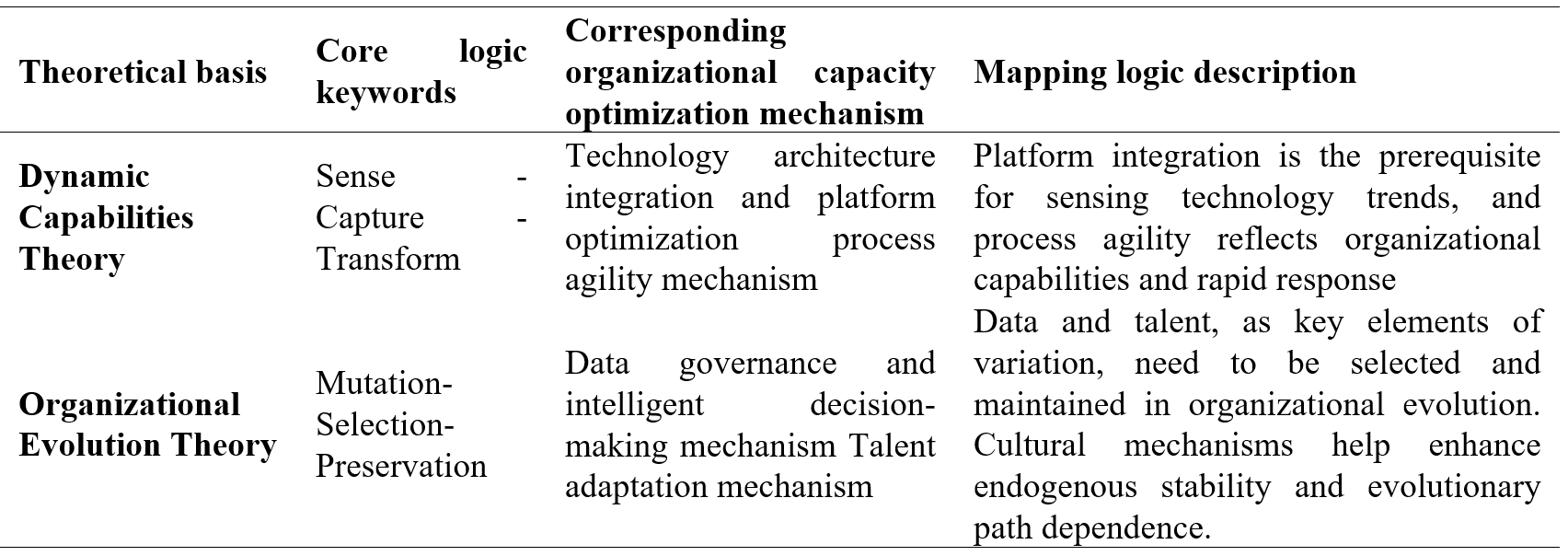Research on the Path of Enterprise Organizational Capability Reconstruction Driven by Digital Intelligence Technology
Abstract
In the context of the digital economy, digital intelligence technologies such as big data, artificial intelligence, and cloud computing are gradually influencing and changing the operating mechanisms and competitive paradigms of enterprises. In this wave of technological change, the original organizational capabilities of enterprises are facing bottlenecks such as process rigidity, data silos, and lagging talent structure. If the organizational inertia and capability lock-in cannot be broken in time, the enterprise will miss the window of strategic transformation. This article focuses on the dynamic adaptation mechanism between digital intelligence technology and organizational capabilities, systematically analyzes its reconstruction path in terms of organizational structure, process system, talent allocation, and cultural identity, reveals the internal logic and key drivers of the evolution of organizational capabilities in the context of technology embedding, and provides theoretical reference and practical guidance for enterprises to build resilience and sustainable competitive advantages in complex environments.
References
[2] Vial, G. (2019). Understanding digital transformation: A review and a research agenda. The Journal of Strategic Information Systems, 28(2), 118–144. https://doi.org/10.1016/j.jsis.2019.01.003
[3] Li, Y., & Yang, M. (2023). Research on the governance mechanism of enterprise big data resources based on financial sharing. Price Theory and Practice, (4), 104–108.
[4] Li, B., Huang, Y., & Liu, F. (2025). Research on the configuration and evolution path of organizational capabilities in the digital platform ecosystem: A comparative case study based on manufacturing enterprises. Accounting Research, (2), 85–95.
[5] Lin, J., Wu, S., & Luo, X. (2025). How does big data analytics capability affect firm performance? Unveiling the role of organizational resilience and environmental dynamism. European Journal of Information Systems, 34(3), 502–528. https://doi.org/10.1080/0960085X.2024.2333458
[6] Ćirović, D., Dabić, M., Melović, B., & Backović, T. (2025). Unleashing SME innovation in small open economies: The strategic role of market dynamism, R&D, and organizational capabilities. Review of Managerial Science. https://doi.org/10.1007/s11846-025-00815-5
[7] Yeboah, J., & Zogli, L. K. J. (2025). Evaluating the influence of organizational resources and learning capabilities on the performance of small, micro, and medium enterprises (SMMEs) in Ghana. Scientific African, 28, e02740. https://doi.org/10.1016/j.sciaf.2025.e02740
[8] de Abreu Saraiva Monteiro Alves, A., & Manuel Pereira de Oliveira Carvalho, F. (2025). Dynamic managerial capabilities and organizational change capacity as precursors of organizational dynamic capabilities in SMEs. Journal of Strategy and Management, 18(2), 386–409. https://doi.org/10.1108/JSMA-04-2024-0099
[9] Xiao, Y. (2025). Pathways to scaling up in emerging economies: A configurational analysis of organizational capabilities in social enterprises. Journal of Business Research, 189, 115091. https://doi.org/10.1016/j.jbusres.2024.115091
[10] Le, T. H., & Khuong, M. N. (2025). Fostering SME’s organizational effectiveness through strategic orientations, learning capability, and innovation. Journal of Small Business Management, 63(1), 249–278. https://doi.org/10.1080/00472778.2023.2246157
[11] Guo, J., Lin, J., & Benitez, J. (2025). How does big data analytics capability affect organizational resilience? The moderating role of data-driven culture and agribusiness environmental dynamism. Information & Management, 62(6), 104179. https://doi.org/10.1016/j.im.2025.104179
[12] Zhu, W. H. (2021). Systematic methodology for digital transformation of manufacturing industry. Peking University Press.
[13] Yu, D., & Zhang, W. (2022). Intellectual capital, knowledge management capabilities and open innovation performance of enterprise organizations. Science and Technology Progress and Policy, 39(9), 122–131.
[14] Zhang, Z. (2022). An empirical study on the relationship between organizational inertia, digital capabilities and business model innovation of Internet companies [Master’s thesis, Harbin University of Commerce].
[15] Li, H. (2023). Research on improving the organizational capabilities of Company A from the perspective of Yang’s triangle theory [Master’s thesis, Yunnan Normal University].
[16] Liu, B. (2023). The impact of knowledge co-creation in innovation ecosystem on the breakthrough innovation of core enterprises [Doctoral dissertation, University of Electronic Science and Technology of China].
[17] Wulijitu, & Dong, M. (2024). Enterprise organizational capabilities, information structure and knowledge creation: Tesla’s innovation power source. Accounting Monthly, 45(22), 96–102.
[18] Liu, J. (2024). On the key role of human resources in promoting enterprise organizational change. Enterprise Reform and Management, (14), 81–83.
[19] Nelson, R. R., & Winter, S. G. (1982). An evolutionary theory of economic change. Harvard University Press.


This work is licensed under a Creative Commons Attribution 4.0 International License.
Copyright for this article is retained by the author(s), with first publication rights granted to the journal.
This is an open-access article distributed under the terms and conditions of the Creative Commons Attribution license (http://creativecommons.org/licenses/by/4.0/).
























